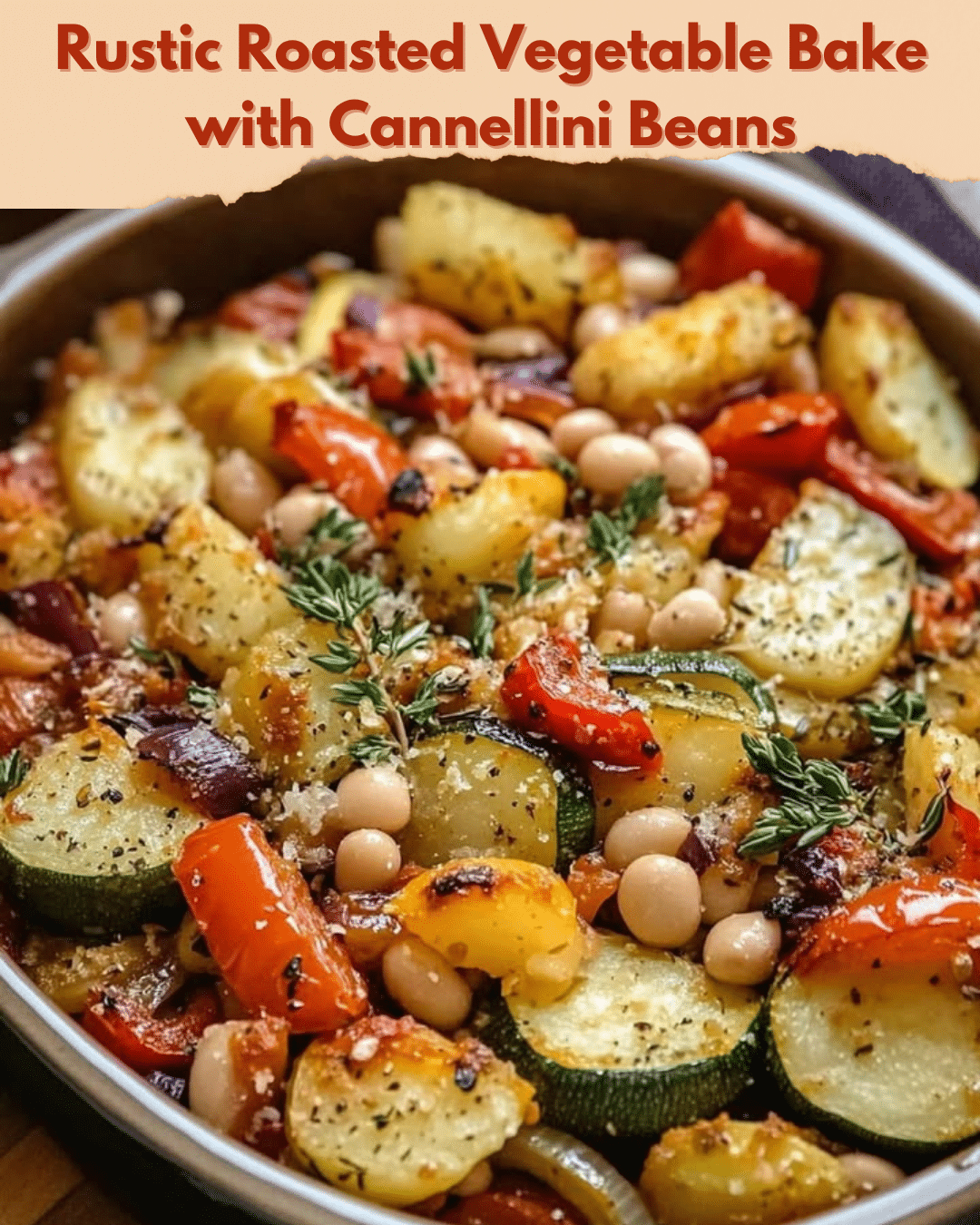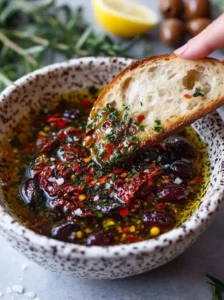Rustic Roasted Vegetable Bake with Cannellini Beans: A Wholesome Delight
Indulge in the flavors of fall with our Rustic Roasted Vegetable Bake with Cannellini Beans. This heartwarming dish brings together an array of vegetables, roasted to perfection, alongside plump cannellini beans for a protein-packed, satisfying meal. The vegetables caramelize beautifully in the oven, developing a delightful sweetness that perfectly complements the earthy beans. This rustic bake is not just a treat for the taste buds but a feast for the eyes with its vibrant colors.
Embrace the comforting aromas that this dish fills your kitchen with, a fragrant medley of roasted garlic, thyme, and fresh herbs. This hearty bake is as inviting as it is delicious, perfect for cozy family dinners or a simple gathering with friends. With seasonal vegetables taking center stage, this is a nutritious and delicious option, featuring nutritional powerhouses such as sweet potatoes, zucchini, and bell peppers.
Quick Recipe Highlights
- Flavor Profile: A delightful combination of sweet, savory, and earthy notes with a hint of herbaceous freshness.
- Texture: The dish offers a satisfying blend of tender, caramelized vegetables alongside creamy beans, creating a perfect mouthfeel.
- Aroma: Rich and aromatic, the smell of roasting vegetables and fresh herbs creates an inviting ambiance.
- Visual Appeal: Bursting with color, this bake features an array of vibrant hues from the vegetables, creating a stunning presentation.
- Skill Level Needed: Beginner-friendly with simple techniques, making it a great option for cooks of all levels.
- Special Equipment: A large roasting pan and a mixing bowl are all you need for this straightforward recipe.
Recipe Overview
- Difficulty Level: This Rustic Roasted Vegetable Bake with Cannellini Beans is designed for simplicity. The straightforward nature of roasting ensures that even novice cooks can create an impressive dish easily.
- Category: This bake fits into categories such as healthy meals, vegetarian dishes, and family favorites, offering flexibility for different dietary preferences.
- Cuisine: Drawing inspiration from Mediterranean influences, this dish shines with its fresh, herb-packed flavors and contributes to wholesome European cuisine.
- Cost: Economical and budget-friendly, this recipe utilizes readily available ingredients, making it affordable without sacrificing flavor.
- Season: Best enjoyed in fall and winter when root vegetables are in their prime, providing cozy warmth during the cooler months.
- Occasion: Ideal for casual family dinners, potlucks, or even meal prepping for busy weeks.
Why You’ll Love This Recipe
Experience the incredible taste and texture that makes this Rustic Roasted Vegetable Bake with Cannellini Beans irresistible. Every bite delivers a combination of rich flavors, thanks to the caramelization that occurs during roasting. The tender vegetables offer a satisfying contrast to the creamy cannellini beans, making it a wholesome meal perfect for any time of day.
Beyond taste, the convenience of preparation is a major perk. With just a few simple steps of chopping vegetables and mixing them with beans, this dish comes together effortlessly. Plus, the bake can easily be scaled up for larger gatherings, providing ample servings for your guests.
From a nutritional standpoint, this dish is a powerhouse. Packed with fiber, protein, and essential vitamins, it caters to a well-rounded and balanced diet. The presence of antioxidants in the vegetables contributes to overall health, making it a smart choice for mindful eating.
Socially and in terms of entertaining, the bake is a communal delight. Its colorful presentation promises to impress at any table, and it can be a perfect conversation starter about healthy eating. Furthermore, its adaptability to different dietary requirements makes it suitable for vegan and vegetarian diets alike.
Lastly, this dish is highly cost-effective and accessible. Utilizing affordable and readily available ingredients, it delivers premium flavors without a premium price tag. This factor, coupled with its robust taste profile, makes it a staple recipe worth revisiting frequently.
Historical Background and Cultural Significance
The origin story of this dish lies in the Mediterranean region, known for its vibrant and vegetable-rich cuisine. Roasting vegetables has been a longstanding tradition, offering a method that amplifies natural flavors and enhances texture. The addition of beans such as cannellini dates back centuries, long celebrated for their protein content and hearty nature.
Culturally, this dish represents the essence of Mediterranean cuisine, emphasizing fresh, in-season produce and simple preparation methods. It embodies the Mediterranean diet’s principles, which have been linked to numerous health benefits due to their reliance on plant-based ingredients.
Over time, the recipe has evolved, incorporating various regional twists that add unique flavors and ingredients. From the Provence region’s inclusion of herbs like thyme and rosemary to Italy’s emphasis on high-quality olive oil, each adaptation tells its own culinary story.
Regional variations of this dish add an extra layer of interest. For example, Northern European versions might include root vegetables like parsnips, while Southern regions may opt for an abundance of peppers and tomatoes. Each variation maintains the core concept of celebrating vegetables while introducing localized components.
Ingredient Deep Dive
Sweet Potatoes: Sweet potatoes serve a dual purpose in this dish by providing natural sweetness and vibrant color. Culturally, they have been staple crops in various regions, celebrated for their versatility. Nutritionally, they’re rich in vitamins A and C, making them an excellent choice for boosting immune health. When selecting sweet potatoes, look for firm ones with smooth skin to ensure longevity. Consider storing them in a cool, dark place to prevent sprouting, and explore alternatives like yams or squash if desired.
Cannellini Beans: These beans are not just a protein supplement but a traditional ingredient woven into the fabric of Mediterranean cuisine. Boasting a rich history, they have been a staple in Italian dishes, prized for their creamy texture and mild flavor. Cannellini beans add significant nutritional benefits, including fiber and iron, crucial for a balanced diet. Opt for canned if in need of convenience, selecting brands without added salt for maximum control over flavor.
Common Mistakes to Avoid
Using under-ripe vegetables: Ensure all vegetables are ripe and fresh to avoid uneven roasting and compromised flavor.
Overcrowding the baking pan: This can steam the vegetables rather than roast them, leading to mushiness. Use multiple pans if needed.
Skipping the seasoning: Properly seasoning with salt, pepper, and herbs is essential for a flavorful dish.
Ignoring oil distribution: Ensure all vegetables are coated with oil for even roasting and caramelization.
Underestimating bake time: Roasting for too short a time doesn’t allow for caramelization and flavor depth.
Avoiding the garlic: Fresh garlic truly elevates the dish’s flavor; using it judiciously enhances aromatic undertones.
Neglecting to stir: Stir the bake halfway through to ensure even cooking and prevent burning at the edges.
Forgetting parchment paper: It prevents sticking and allows for effortless cleanup.
Ignoring ingredient swaps: Be open to substitutions based on what’s in season or personal preference, like swapping zucchini with eggplant.
Under-seasoning post-roast: Taste and adjust seasoning before serving for optimal flavor.
Essential Techniques
Roasting Vegetables to Perfection: The art of roasting involves more than just heat; understanding the interplay between temperature and time is crucial. Master this by experimenting with a variety of vegetables and sizes. Ensure uniformity by chopping vegetables to similar sizes for even cooking, and space them out to encourage caramelization.
Balancing Flavors: Achieving the perfect balance of flavors involves adjusting seasoning and utilizing herbs. Freshly ground black pepper adds depth, while salt enhances natural sweetness. Taste and modify as required to reach the pinnacle of flavor harmony.
Oil Distribution: Even oil distribution is vital. Mix the vegetables thoroughly with a high-quality oil, ensuring each piece is coated completely. This method enhances the roasting effects and creates that desired crisp exterior.
Pro Tips for Perfect Rustic Roasted Vegetable Bake with Cannellini Beans
To enhance caramelization, preheat your pan in the oven before adding vegetables.
Consider combining oils, such as olive and avocado, for an enriched flavor profile.
Explore adding a splash of balsamic vinegar for tang and depth.
Include different beans for variety in color and texture.
Toss with freshly chopped herbs just before serving for a burst of flavor.
Mix in toasted nuts like walnuts or pine nuts for added crunch.
Incorporate a citrus zest for a fresh twist.
To ensure perfect roasting every time, batch cook the vegetables in staggered stages, focusing on those needing more time.
Variations and Adaptations
To embrace regional variations, explore adding robust herbs like oregano or marjoram for a more Italian-inspired dish. When considering seasonal adaptations, swap summer squash with winter squash varieties like butternut during colder months. Dietary modifications include using low-sodium canned beans or pivoting to a fully plant-based oil for vegan flair.
For flavor variations, incorporate spices such as smoked paprika for a smoky essence or cumin for warmth. Texture modifications can involve experimenting with different bean types or introducing grains like quinoa for added substance. Presentation alternatives include serving in individual ramekins for personalized portions or adding a dollop of yogurt for creamy contrast.
Serving and Presentation Guide
Plating plays a crucial role in the experience of this dish. Consider using wide, shallow bowls to creatively showcase the vibrant vegetables. Garnishing with freshly chopped parsley or a sprinkle of feta cheese adds visual appeal and depth.
Traditionally accompanying the bake with crusty bread can elevate the dining experience. For modern serving suggestions, pair it with a crisp green salad or a dollop of hummus for complementary flavors. Maintain the ideal serving temperature by warming plates beforehand, ensuring each bite remains invitingly warm.
Wine and Beverage Pairing
A versatile dish like this pairs wonderfully with a range of wines. Opt for a light-bodied red like a Pinot Noir or a white such as a Sauvignon Blanc to complement the dish’s earthy tones. Non-alcoholic alternatives, such as sparkling water with a squeeze of lemon, provide a refreshing contrast.
For unique pairings, consider herbal teas, which beautifully resonate with the roasted garlic and thyme’s aroma. Keep beverages slightly chilled to elevate the dish’s warm textures, offering balance and harmony. Within servings, consider using decanters for wine aeration or carafes for stylish non-alcoholic displays.
Storage and Shelf Life
Storing the bake correctly is paramount for preserving its deliciousness. Allow it to cool to room temperature before transferring it into airtight containers. Refrigerate to maintain freshness over several days, but consume within four days to avoid spoilage. To identify signs of spoilage, look for off-putting smells or mold, discarding if discovered.
Reheating should be cautious to prevent over-drying. Opt for a gentle oven warm-up rather than microwaving, refreshing the bake with a splash of broth if necessary. For freezing, portion the dish into freezer-safe containers, and label with dates for easy tracking.
Make Ahead Strategies
Ideal for meal prep, divide the task into stages: chop vegetables in advance and store them in the refrigerator until ready to roast. Assemble and season the components shortly before baking to ensure peak flavor.
To maintain quality between steps, store chopped vegetables separately from cannellini beans to prevent moisture transfer. Follow assembly tips to streamline the process, arranging ingredients methodically in a pre-determined order. Reheat with mindfulness of texture, and add fresh herbs post-oven for a vibrant finish.
Scaling Instructions
Scaling up or down requires mindful ingredient adjustments. Doubling the quantities results in a grander feast while maintaining the recipe’s essence. Equipment considerations, such as larger roasting pans, prevent flavor compromise.
Account for adjusted cooking times when scaling and monitor for desired browning outcomes. Storage flexibility is pivotal; keep excess portions sealed to maintain freshness and adapt reheating techniques based on the scale.
Nutritional Deep Dive
This dish offers a balanced macro breakdown, providing carbohydrates from root vegetables, protein from beans, and healthy fats from olive oil. Micronutrient analysis reveals a wealth of vitamin C, potassium, and fiber, ideal for bolstering dietary intake.
Focusing on health benefits, sweet potatoes fuel energy levels, mirroring the beans’ satiating protein content. In terms of portion analysis, serve as a primary dish or side depending on caloric needs, promoting mindful consumption. For weight management, emphasize vegetable bulk over beans in portion sizing.
Dietary Adaptations
For gluten-free adaptation, confirm all additional ingredients, such as broth, are gluten-free certified. Dairy-free concerns are negated if the optional feta topping is excluded.
Vegan options are naturally upheld, courtesy of the plant-centric components and olive oil base. For low-carb or keto variations, replace root vegetables with cauliflower or zucchini, reducing carbohydrate content significantly.
Paleo considerations involve using sweet potatoes sparingly, maintaining harmony with hunter-gatherer principles. Low-FODMAP alterations focus on reducing garlic or using garlic-infused oil, perfecting taste without gastrointestinal compromise.
Troubleshooting Guide
To combat texture issues, fine-tune roasting time by observing visual cues such as caramelization. Address flavor imbalances by adjusting salt, herbs, or acidity post-roasting.
Temperature challenges may stem from uneven oven heat; rotating pans halfway through may correct this. If equipment proves lacking, substitute with alternatives like cast iron for consistency. Ingredient substitutions such as different beans or oils can introduce new flavors while maintaining dish integrity.
Recipe Success Stories
Our community raves about this dish’s adaptability, sharing variations such as adding mushrooms or integrating a variety of squash. Testimonials include readers who have successfully personalized with additional spices, offering fragrant alternatives.
Engagement extends to photography tips, showcasing artsy interpretations of vibrant plating. Adaptation stories include creative vegan alternatives, resonating well with plant-based enthusiasts.
Frequently Asked Questions
A: Absolutely, you can choose navy or great northern beans as substitutes, maintaining similar creamy textures while introducing slight flavor nuances.
Q: How long should I roast the vegetables for optimal texture?
A: Roast until they achieve a golden-brown exterior, typically around 40 minutes, to maximize flavor and create tender interiors with a crisp outer layer.
Q: What temperature works best for roasting?
A: Maintain a consistent 425°F (220°C) to ensure vegetables roast evenly, creating caramelization while preserving tender centers.
Q: Can I prepare this dish in advance for parties?
A: Yes! Pre-chop vegetables and store them, assembling the bake shortly before roasting for fresh flavors without last-minute stress.
Q: How do I make this dish more kid-friendly?
A: Introduce familiar vegetables like carrots or sweet corn, adding a sprinkle of cheese at the end for a comforting, kid-pleasing touch.
Q: Are there gluten-free versions available?
A: Certainly! Confirm that all supplemental ingredients are gluten-free certified, like choosing broths without wheat-based thickeners.
Q: What olive oil works best for this recipe?
A: Opt for extra virgin olive oil, known for its rich, fruity taste which complements the flavors without overpowering them.
Q: Can I make this dish spicy?
A: For a bit of heat, incorporate red pepper flakes or diced chili peppers, adjusting to your preference for additional warmth.
Q: How much salt should I use when seasoning?
A: Start with ½–1 teaspoon of sea or kosher salt, tasting and modifying as needed based on personal preference.
Q: Is it possible to add protein to this dish?
A: Enhance protein by incorporating grilled chicken or sautéed shrimp, layering on top before the final roast.
Additional Resources
For those eager to explore further culinary adventures, consider other roasted vegetable recipes like our Spiced Roasted Root Vegetables or Mediterranean Bean Stew. Technique guides delve into mastering the art of oven-roasting across vegetables, enhancing proficiency.
Discover more ingredient information spotlighting the nutritional virtues of seasonal produce and the significance of quality herbs. Elevate equipment readiness with recommendations on top brands for roasting pans and essential kitchen tools. Embrace seasonal variations not only in this recipe but across your cooking journey.
Print
Rustic Roasted Vegetable Bake with Cannellini Beans
Description
A hearty and wholesome dish featuring roasted vegetables and protein-packed cannellini beans, perfect for a comforting meal.
Ingredients
For the Crust:
- 2 cups cubed butternut squash
- 1 red bell pepper, sliced
- 1 red onion, chopped
- 1 zucchini, sliced
- 2 tbsp olive oil
- 1 tsp dried thyme
- 1 tsp dried rosemary
- Salt and pepper to taste
- 1 can (15 oz) cannellini beans, drained and rinsed
- 1/4 cup grated Parmesan cheese
Instructions
1. Prepare the Crust:
- Preheat the oven to 400°F (200°C).
- In a large mixing bowl, combine butternut squash, bell pepper, red onion, and zucchini. Drizzle with olive oil and sprinkle with thyme, rosemary, salt, and pepper.
- Spread the vegetables in a single layer on a baking sheet and roast for 25 minutes, stirring halfway through cooking.
- Remove from the oven, add the cannellini beans, and gently mix with the vegetables. Sprinkle Parmesan cheese over the top.
- Return to the oven for another 5 minutes until the cheese is melted and bubbly.
Notes
You can customize the seasonings to taste.





